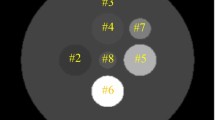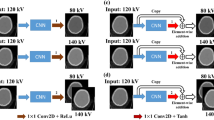Abstract
Material decomposition (MD) is an application of dual-energy computed tomography (DECT) that decomposes DECT images into specific material images. However, the direct inversion method used in MD often amplifies noise in the decomposed material images, resulting in lower image quality. To address this issue, we propose an image-domain MD method based on the concept of deep image prior (DIP). DIP is an unsupervised learning method that can perform different tasks without using a large training dataset with known targets (i.e., basis material images). We retrospectively recruited patients who underwent non-contrast brain DECT scans and investigated the feasibility of using the proposed DIP-based method to decompose DECT images into two (i.e., bone and soft tissue) and three (i.e., bone, soft tissue, and fat) basis materials. We evaluated the decomposed material images in terms of signal-to-noise ratio (SNR) and modulation transfer function (MTF). The proposed DIP-based method showed greater improvement in SNR in the decomposed soft-tissue images compared to the direct inversion method and the iterative method. Moreover, the proposed method produced similar MTF curves in both two- and three-material decompositions. Additionally, the proposed DIP-based method demonstrated better separation ability than the other two studied methods in the case of three-material decomposition. Our results suggest that the proposed DIP-based method is capable of unsupervisedly generating high-quality basis material images from DECT images.







Similar content being viewed by others
References
Goo HW, Goo JM (2017) Dual-energy CT: new horizon in medical imaging. Korean J Radiol 18:555–569
Yu L, Christner JA, Leng S et al (2011) Virtual monochromatic imaging in dual-source dual-energy CT: radiation dose and image quality. Med Phys 38:6371–6379
Schulz B, Kuehling K, Kromen W et al (2012) Automatic bone removal technique in whole-body dual-energy CT angiography: performance and image quality. AJR Am J Roentgenol 199:646–650
Patino M, Prochowski A, Agrawal MD et al (2016) Material separation using dual-energy CT: current and emerging applications. Radiographics 36:1087–1105
Jacobsen MC, Cressman ENK, Tamm EP et al (2019) Dual-energy CT: lower limits of iodine detection and quantification. Radiology 292:414–419
Alvarez RE, MacOvski A (1976) Energy-selective reconstructions in X-ray computerized tomography. Phys Med Biol 21:733–744
Kalender WA, Klotz E, Kostaridou L (1988) An algorithm for noise suppression in dual energy CT material density images. IEEE Trans Med Imaging 7:218–224
Siegel MJ, Bhalla S, Cullinane M (2021) Dual-energy CT material decomposition in pediatric thoracic oncology. Radiol Imaging Cancer 3:e200097
Agrawal MD, Pinho DF, Kulkarni NM et al (2014) Oncologic applications of dual-energy CT in the abdomen. Radiographics 34:589–612
Kalender WA, Perman WH, Vetter JR, Klotz E (1986) Evaluation of a prototype dual-energy computed tomographic apparatus. I. phantom studies. Med Phys 13:334–339
Cong W, De Man B, Wang G (2022) Projection decomposition via univariate optimization for dual-energy CT. J Xray Sci Technol 30:725–736
Long Y, Fessler JA (2014) Multi-material decomposition using statistical image reconstruction for spectral CT. IEEE Trans Med Imaging 33:1614–1626
Mendonca PRS, Lamb P, Sahani DV (2014) A flexible method for multi-material decomposition of dual-energy CT images. IEEE Trans Med Imaging 33:99–116
Szczykutowicz TP, Chen GH (2010) Dual energy CT using slow kVp switching acquisition and prior image constrained compressed sensing. Phys Med Biol 55:6411–6429
Kelcz F, Joseph PM, Hilal SK (1979) Noise considerations in dual energy CT scanning. Med Phys 6:418–425
Niu T, Dong X, Petrongolo M, Zhu L (2014) Iterative image-domain decomposition for dual-energy CT. Med Phys 41:041901
Ding Q, Niu T, Zhang X, Long Y (2018) Image-domain multimaterial decomposition for dual-energy CT based on prior information of material images. Med Phys 45:3614–3626
Lyu Q, O’Connor D, Niu T, Sheng K (2019) Image-domain multimaterial decomposition for dual-energy computed tomography with nonconvex sparsity regularization. J Med Imaging 6:044004
Jiang Y, Zhang X, Sheng K et al (2020) Noise suppression in image-domain multi-material decomposition for dual-energy CT. IEEE Trans Biomed Eng 67:523–535
Yasaka K, Akai H, Kunimatsu A et al (2018) Deep learning with convolutional neural network in radiology. Jpn J Radiol 36:257–272
Currie G, Hawk KE, Rohren E et al (2019) Machine learning and deep learning in medical imaging: intelligent imaging. J Med Imaging Radiat Sci 50:477–487
Qadri SF, Ai D, Hu G et al (2019) Automatic deep feature learning via patch-based deep belief network for vertebrae segmentation in CT images. Appl Sci 9:69
Ahmad M, Ai D, Xie G et al (2019) Deep belief network modeling for automatic liver segmentation. IEEE Access 7:20585–20595
Qadri SF, Shen L, Ahmad M et al (2021) OP-convNet: a patch classification-based framework for CT vertebrae segmentation. IEEE Access 9:158227–158240
Xu Y, Yan B, Chen J et al (2018) Projection decomposition algorithm for dual-energy computed tomography via deep neural network. J Xray Sci Technol 26:361–377
Zhang W, Zhang H, Wang L et al (2019) Image domain dual material decomposition for dual-energy CT using butterfly network. Med Phys 46:2037–2051
Su T, Sun X, Yang J et al (2022) DIRECT-Net: a unified mutual-domain material decomposition network for quantitative dual-energy CT imaging. Med Phys 49:917–934
Lempitsky V, Vedaldi A, Ulyanov D (2018) Deep image prior. https://arxiv.org/abs/1711.10925
Liu CK, Huang HM (2021) Unsupervised deep learning based image outpainting for dual-source, dual-energy computed tomography. Radiat Phys Chem 188:109635
Liu X, Yu L, Primak AN, McCollough CH (2009) Quantitative imaging of element composition and mass fraction using dual-energy CT: three-material decomposition. Med Phys 36:1602–1609
Ronneberger O, Fischer P, Brox T (2015) U-Net: convolutional networks for biomedical image segmentation. https://arxiv.org/abs/1505.04597
Kingma DP, Ba JL (2015) Adam: A method for stochastic optimization. https://arxiv.org/abs/1412.6980
Samei E, Flynn MJ, Reimann DA (1998) A method for measuring the presampled MTF of digital radiographic systems using an edge test device. Med Phys 25:102–113
Magnusson M, Alm Carlsson G, Sandborg M et al (2021) Optimal selection of base materials for accurate dual-energy computed tomography: comparison between the Alvarez–Macovski method and DIRA. Radiat Prot Dosimetry 195:218–224
Zhou Q, Zhou C, Hu H et al (2019) Towards the automation of deep image prior. https://arxiv.org/abs/1911.07185
Wang H, Li T, Zhuang Z et al (2021) Early stopping for deep image prior. https://arxiv.org/abs/2112.06074
Funding
This work was supported by MOST 111-2221-E-002-069 from Ministry of Science Technology, Taiwan.
Author information
Authors and Affiliations
Corresponding author
Ethics declarations
Competing interest
The authors have not disclosed any competing interests.
Ethical approval
Ethics (IRB No. 230213) approval was approved by Institutional Review Board Committee B Changhua Christian Hospital.
Additional information
Publisher’s Note
Springer Nature remains neutral with regard to jurisdictional claims in published maps and institutional affiliations.
Rights and permissions
Springer Nature or its licensor (e.g. a society or other partner) holds exclusive rights to this article under a publishing agreement with the author(s) or other rightsholder(s); author self-archiving of the accepted manuscript version of this article is solely governed by the terms of such publishing agreement and applicable law.
About this article
Cite this article
Chang, HY., Liu, CK. & Huang, HM. Material decomposition using dual-energy CT with unsupervised learning. Phys Eng Sci Med 46, 1607–1617 (2023). https://doi.org/10.1007/s13246-023-01323-7
Received:
Accepted:
Published:
Issue Date:
DOI: https://doi.org/10.1007/s13246-023-01323-7




